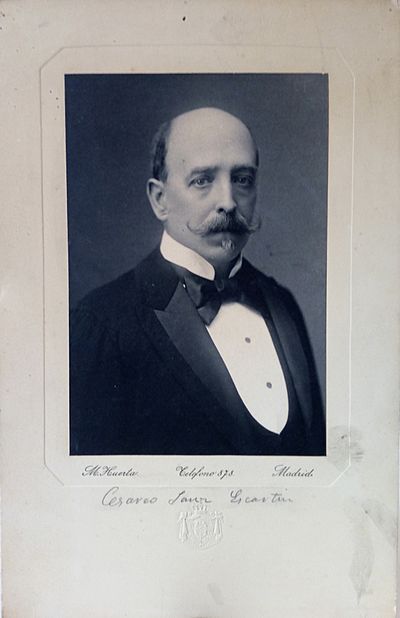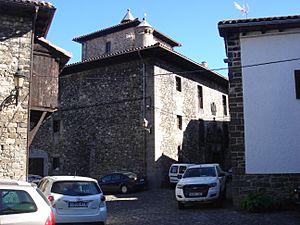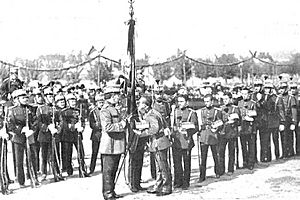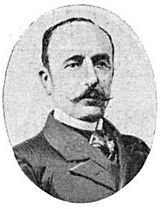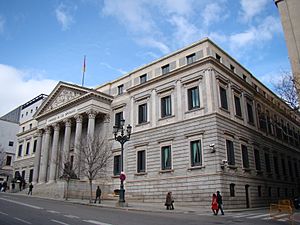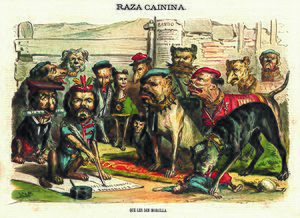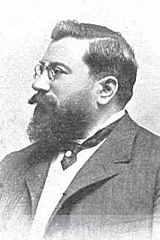Cesáreo Sanz Escartín facts for kids
Quick facts for kids
Cesáreo Sanz Escartín
|
|
|---|---|
|
|
|
| Born |
Cesáreo Sanz Escartín
1844 Pamplona, Spain
|
| Died | 1923 Madrid, Spain
|
| Nationality | Spanish |
| Occupation | entrepreneur |
| Known for | politician |
| Political party | Carlism |
Romualdo Cesáreo Sanz Escartín (1844-1923) was a Spanish Carlist politician and military leader. He is best known for being a member of the Spanish Parliament, first as a deputy and later as a senator. He represented Navarre in both roles. From 1918 to 1919, he was also the temporary leader of the Carlist political group in Spain.
Contents
Early Life and Family
Cesáreo Sanz Escartín's family came from the Valle de Roncal, a mountainous area in the Pyrenees region of Navarre. His family, the Sanz and Amigot families, had lived there for centuries.
His grandfather, Agustín Mariano Sanz López, was from Roncal. The family owned a famous house there. Cesáreo's father, Juan Nepomuceno, was a captain in the Carabineros, a type of police force. Other family members also served in the military or police.
Cesáreo's parents settled in Pamplona. Because his family had a strong military background, Cesáreo was expected to join the army. In 1857, at age 13, he became a cadet at the Infantry College in Toledo. He finished his studies in 1861 and became a junior officer, called an alférez. Because he was an excellent student, he stayed at the academy as a teacher for cadets.
Cesáreo Sanz Escartín married Cristeta Amóros. They lived mostly in Toledo but also had an apartment in Madrid. They did not have any children. Two of his relatives became well-known: his cousin, Eduardo Sanz y Escartín, was a Conservative politician and a pioneer in sociology. Another relative, Fermín Sanz-Orrio y Sanz, became a minister during the Francoism era.
Military Career and the Carlist War

In the mid-1860s, Sanz was a lieutenant in the army. In 1868, his unit fought against revolutionaries in Béjar. After this, he was promoted to captain and returned to teaching in Toledo.
His military career ended when the First Spanish Republic was declared. He left the army and joined the Carlists, a political movement that supported a different royal family. The Carlists were starting a civil war. Sanz headed north to join the fight. His uncle, Cesáreo Sanz López, was already a high-ranking Carlist military leader.
Sanz refused an immediate promotion to commander. He was assigned to troops in Navarre. He fought in battles like Allo and Dicastillo in 1873. He then helped capture Estella and lay siege to Viana and Lumbier. He earned his commander stripes on the battlefield. Later that year, he organized and led the 9th Battalion of Navarre.
In June 1874, Sanz led a brave attempt to capture Lumbier. He was nearly killed when he was cut off from his troops. In late 1874, he led his battalion in battles at Rocafuerte, Abárzuza, and Sangüesa. He was known for his calm and bravery under fire. During a fight at Santa Margarita, his horse was shot, and he was promoted to lieutenant colonel.

In late 1874, Sanz took command of a larger group of battalions. They fought on the Aragon front and tried to capture Pamplona. After the battle of Artazu, he was promoted to colonel. He then became chief of staff for the Navarre Division. He helped plan the capture of Lumbier in October 1875.
As the Carlist war effort weakened, Sanz helped organize new, temporary army units. When Conde de Caserta took command of the Carlist army, Sanz became his second-in-command. The Carlist troops were retreating. In February 1876, Sanz crossed into France as the war ended. By then, he was a brigadier general.
Life in Toledo and the Academy
Sanz's exile in France was short. He returned to Spain before the summer of 1877 and settled back in Toledo. As a discharged officer, he did not receive a military pension. He decided to use his teaching and military experience to earn a living.
The Toledo Military Infantry College, a key military school, returned to Toledo in 1876 and was renamed the Academy. It was located in the famous Alcázar building. The Academy had a huge impact on Toledo, bringing in many students and creating jobs. This led to the opening of private schools that helped students prepare for the Academy's entry exams. Sanz Escartín opened one of these schools.
His school was called Academia Preparatoria, Colegio de Preparación, or Colegio General Militar. It first opened around 1877. Sanz was always the director. The school continued to enroll students until the early 1900s. Although the school's advertisements didn't mention Sanz's Carlist past, parents who shared his political views often preferred his school. For example, Ignacio Hidalgo de Cisneros, who later commanded the Spanish Republican Air Force, attended Sanz's school as a boy.
Sanz's school was very successful. In 1905, it claimed that 267 of its students had passed the Infantry Academy entry exams. Some even ranked first in their classes. People at the time said Sanz was "greatly successful" in military education. The college sometimes hired other teachers, but it's unclear if Sanz taught himself. Some sources called him a "great mathematician."
After about 30 years of teaching, the college became well-known, and Sanz became an important figure in Toledo. In the 1910s, he joined the Toledo Association of Pedagogical Missions and became a board member. The exact year the college closed is unknown, but its last advertisement was in 1911.
Member of Parliament: Deputy
After their military defeat in 1876, the Carlists faced a difficult period. They did not form an organized political party until the late 1880s. Sanz stayed out of the public eye but remained involved with the party. He subscribed to Carlist newspapers and supported projects like donating money for a monument to Thomas Zumalacarregui.
During a crisis in 1888, when some Carlists left the party, Sanz remained loyal to his king. When the new Carlist leader, Marqués de Cerralbo, decided that the party should participate in national politics, Sanz became a candidate in elections.
In the 1891 election, the Carlists officially put forward candidates for the first time. Sanz Escartín, who lived in Toledo, ran in his home region of Navarre, in the Pamplona district. He won easily, beating candidates from other parties. He was the only one of four Carlists in Navarre to win and one of only seven Carlists elected nationwide.
This victory was the first of many for Sanz. He was re-elected from the same Pamplona district in 1893, 1896, 1898, and 1901. He usually won about 40% of the votes. He was so confident of winning that he rarely traveled during his campaigns. His strongest support came from central Navarre. His winning streak was only broken in 1899, when the Carlists chose not to participate in the elections, and Sanz remained loyal to the party's decision.
Even though Sanz served five terms and nine years in the Congress of Deputies, he was not very active. He was rarely mentioned in the press for giving speeches or proposing laws. It seems he mostly supported initiatives led by other Carlist members of parliament, like Juan Vázquez de Mella. These initiatives covered topics from education to the economy and military issues.
The only time Sanz was mentioned alone was when a committee considered taking legal action against him. This was because of an article he wrote in El Correo Español that was seen as against the constitution. The action was eventually dropped. It is unclear if his quiet performance in parliament led to the end of his time as a deputy. In 1903, he ran again in Pamplona but unexpectedly lost.
Becoming a Field Marshal
After winning his first election, Sanz became one of the most recognizable Carlist figures, even though he had not been very active in the party before. He started coordinating national projects with party leaders and attending public rallies in Pamplona and Madrid. He also used his position as a deputy to protest to authorities about how Carlist activists were treated.
However, for most of the 1890s, he did not hold a major position within the party. It was only in the late 1890s that Sanz became the head of the Carlist group in Madrid. In 1897, he also became the leader of the Carlist party in Navarre.
In the late 1890s, Sanz became one of the most important Carlists. In 1897, he was invited to the king's home in Venice to help write a Carlist statement of beliefs, called the Acta de Loredan. The next year, he was involved in a Carlist plan to start another uprising. In 1899, he was named to a seven-member committee that was supposed to plan the rebellion. He became its top military authority. Carlos VII formally recognized this by making Sanz a field marshal.
The full story of this attempted uprising is unclear. It seems the Carlist leaders postponed the rebellion, but in Catalonia, some isolated revolts, known as La Octubrada, still happened. During this time, Sanz was in Bayonne. It's not clear if this was part of a plan to mislead others or a way to avoid the unrest.
After the uprising, there were big changes in the Carlist leadership. Sanz was not blamed for the events, and some sources say he was still considered for a role as Minister of War in a future Carlist government. However, he resigned from his leadership position in Navarre. He did not lose favor completely, as he was considered for a special committee in 1902. But after losing his parliamentary seat in 1903, he lost his important position within the party.
Member of Parliament: Senator
In 1904, Sanz tried to re-enter the Spanish Parliament, but this time he aimed for the Senate in Navarre. Senators were chosen by a special group of electors, not by popular vote. Sanz was supported as a Carlist candidate. He was already a well-known figure in Navarre. However, his attempt was unsuccessful, and he withdrew before the election was finished.
In the mid-1900s, he generally stepped away from national politics and focused on local activities in Toledo. He joined the board of the local Association of Pedagogical Missions in 1906. In 1908, he became an assistant judge in the Municipal Court. He also helped set up the municipal Chamber of Commerce and became its first president in the early 1910s.
In 1914, Sanz tried again to become a senator from Navarre. This time, he was successful. He was elected among the top three candidates. This victory led to more successes: he was re-elected in 1916, 1918, and 1919. His four terms ended in 1920. It's not clear if he lost or chose to end his parliamentary career.
Unlike his time as a deputy, Sanz was active in the Senate. He proposed a law about officer retirement rules, though he later withdrew it. He participated in many discussions about the army, including its organization, military academies, pay, and the war in Morocco. He was part of committees related to the army and navy, as well as legal, budget, and economic issues. Even though his time in the Senate was during World War I, he was not recorded discussing Spain's position in the war.
Sanz's time in the Senate was mostly calm. He was only criticized once when he was accused of being the "generalissimo" of the Requetés, a new Carlist youth group suspected of sabotage. He denied any involvement. At that time, another Carlist military leader, Joaquín Llorens, led the Requetés. Because of his age and long parliamentary career, Sanz gained a lot of respect. In 1916, members of parliament and senators from Navarre, from all parties, chose him as their dean (leader).
The Mellista Conflict
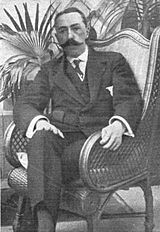
In the 1910s, the Carlist movement was divided by a conflict between the Carlist king, Don Jaime, and the main Carlist thinker, Juan Vázquez de Mella. Sanz, as a senator, was a member of the Carlist Supreme Central Committee. He was not a main figure in the conflict, but his connections placed him among the Mellistas, who supported de Mella.
In 1916, when the Carlist leader in Navarre resigned, Cerralbo appointed Sanz as his replacement. At this time, Don Jaime was under house arrest in Austria, and de Mella's supporters largely controlled the party. Sanz was considered a clear supporter of de Mella.
In early 1918, Marqués de Cerralbo tried to resign as the Carlist political leader. In April 1918, his resignation was accepted, and the committee members elected Sanz as his temporary replacement. At 74 years old, Sanz formally became the Carlist political leader. However, because he couldn't contact his king for final approval, he was called "vice-president of the Supreme Committee" or "acting president."
The second half of 1918 was confusing for the Carlists, with de Mella effectively leading them in Spain. Sanz was not known for any specific actions, except for helping to write a note from the Navarre Provincial Council. This note asked for traditional provincial rights to be restored and aimed to counter Basque nationalist demands.
In early January 1919, Don Jaime arrived in Paris. He immediately demanded that Sanz, de Mella, and de Cerralbo report to him. Sanz expected the worst and even tried to transfer ownership of the party newspaper, El Correo Español, to a company controlled by the Mellistas, possibly preparing for a split. The Spanish Carlists were denied French visas and could not go to Paris. However, as late as February 1919, a clash did not seem certain: Don Jaime confirmed Sanz as the temporary president of the Supreme Committee. Sanz knew that Don Jaime was preparing a strong statement and asked for it to be delayed. He was surprised when it was printed in Correo.
The details of the final split are not clear. There is no known document where Don Jaime officially removed Sanz from the presidency or expelled him from the party. However, in late February 1919, Don Jaime appointed Pascual Comín Moya as the new, temporary party leader. By April, the 75-year-old Sanz was active in the Central Committee of a new, separate Mellista organization. Before the 1920 elections, he was a key Mellist supporter of a non-royalist Monarchist Federation. Once his Senate term ended, he seems to have retired from politics. There is no information about his public activities after 1921.
See also
 In Spanish: Romualdo Cesáreo Sanz y Escartín para niños
In Spanish: Romualdo Cesáreo Sanz y Escartín para niños


